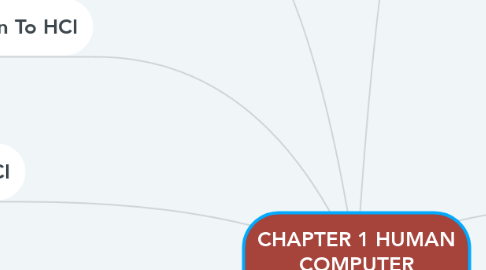
1. Important of HCI
1.1. easy to user understand and how to use the system
2. Introduction To HCI
2.1. Designing computer system that support user to carry out their activities safely and productively
3. HCI Component
3.1. Human
3.1.1. end user
3.2. Computer
3.2.1. machine that run the program
3.3. Interaction
3.3.1. communications result
4. Primary Sense
4.1. Vision
4.2. Hearing
4.3. Touch
5. Model Human Processor
5.1. Perceptual Subsystem
5.1.1. Handling Sensory
5.2. Cognitive Subsystem
5.2.1. Processing needed to connect sensory and action
5.3. Motor Subsystem
5.3.1. Control actions
6. Reason Why Interface Cause Problem to User
6.1. Gulf of Execution
6.1.1. difference between the intentions of the users and what the system allows them to do or how well the system supports those actions
6.2. Gulf of Evaluation
6.2.1. how the user evaluates the result that the system provides
7. Ergonomics
7.1. Designed for efficiency and comfort in the working environment
7.1.1. Aspect in Ergonomics
7.1.1.1. Arrangement of control
7.1.1.2. physical environment
7.1.1.3. Health issues
7.1.1.4. use of colour
8. Interaction Style
8.1. Command Line Interface
8.2. Natural Language
8.3. WIMP (Window,Icon,Menu,Pointer)
8.4. Question / Answer and Query Dialog
8.5. Form-Filling
8.6. Point and Click
8.7. 3D Interfaces
8.8. Menus
9. Human Interaction
9.1. communication between user and system
9.1.1. Term of Interaction
9.1.1.1. Domain
9.1.1.2. Goal
9.1.1.3. Task
9.1.1.4. Intention
10. Model of Interaction
10.1. Norman Execution -Evaluation Cycle
10.1.1. 1. Goals
10.1.2. 2. Intention to Act
10.1.3. 3. Sequence of Actions
10.1.4. 4. Execution of the action sequence
10.1.5. 5. Perceiving the state of the world
10.1.6. 6. Interpriting the perception
10.1.7. 7. Evaluation of interpretations
10.2. Abowd and Beale's interaction Framework
10.2.1. Component
10.2.1.1. 1. User
10.2.1.2. 2. Input
10.2.1.3. 3. Output
10.2.1.4. 4. System
10.2.2. Output ---> User - Oberservation
10.2.3. User ---> Input - Articulation
10.2.4. Input ---> System - Performance
10.2.5. System ---> Output - Presentation

